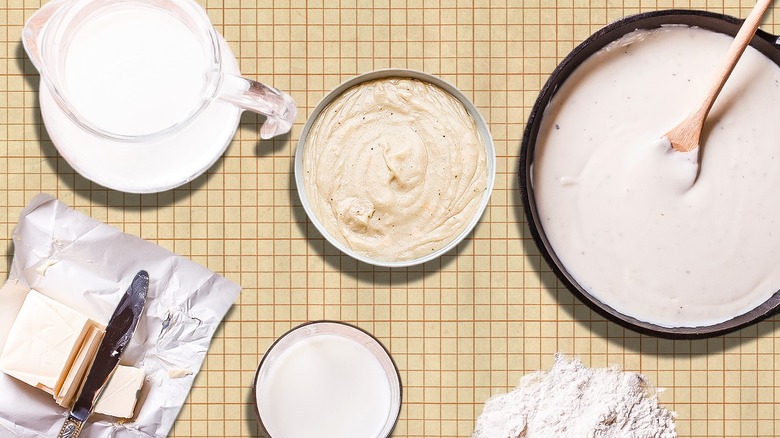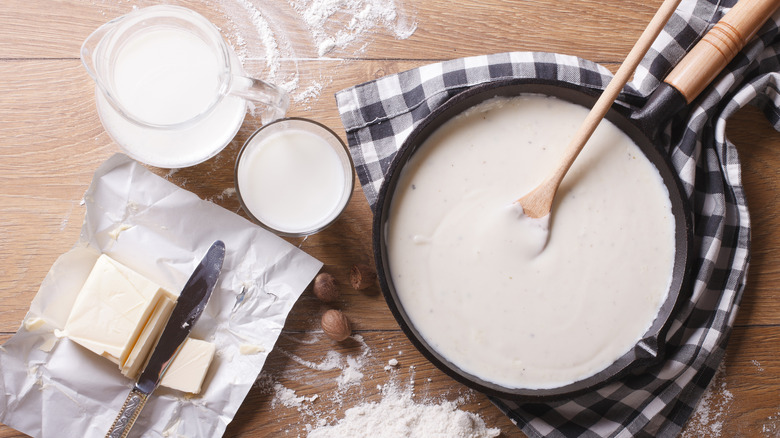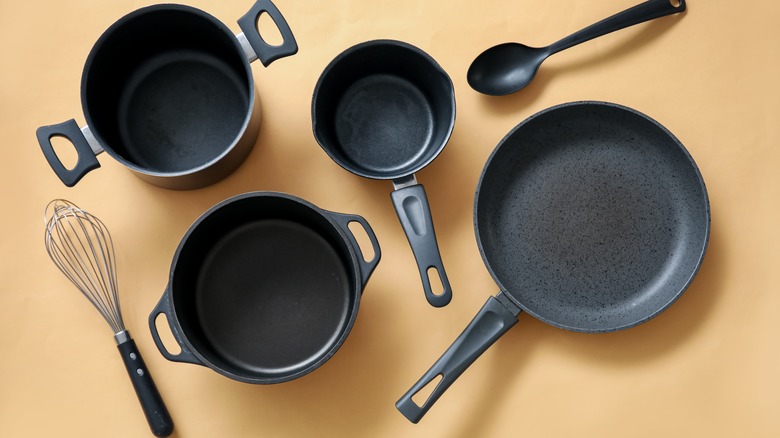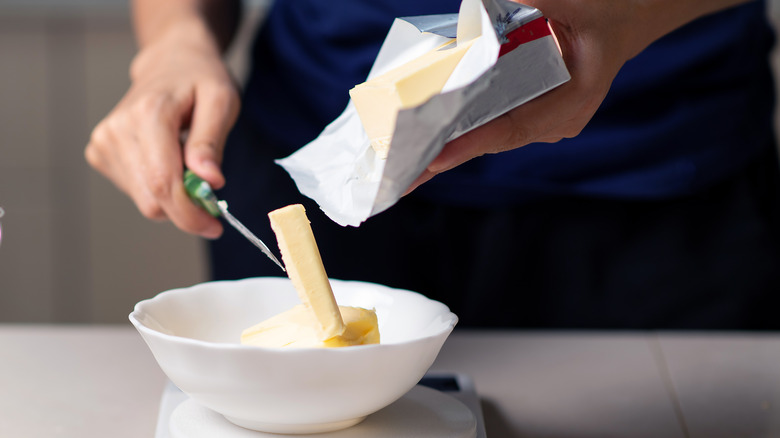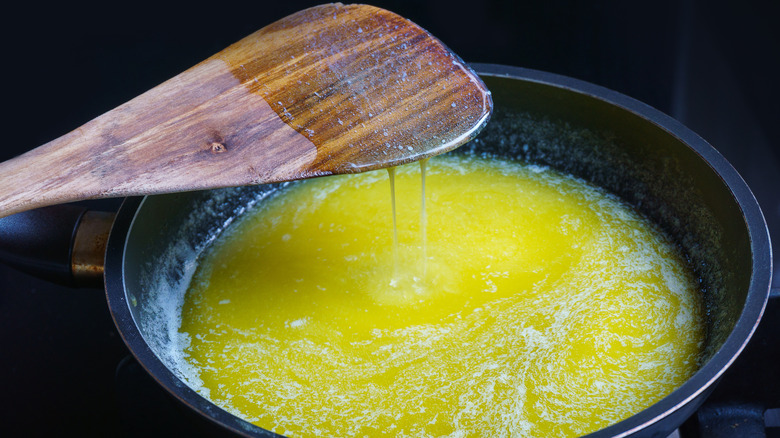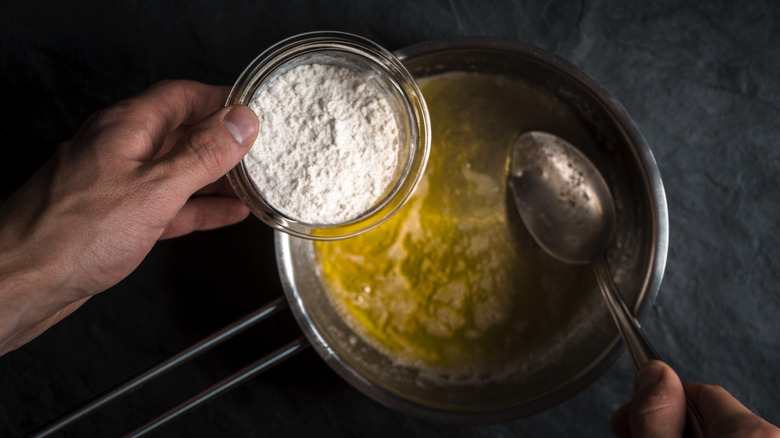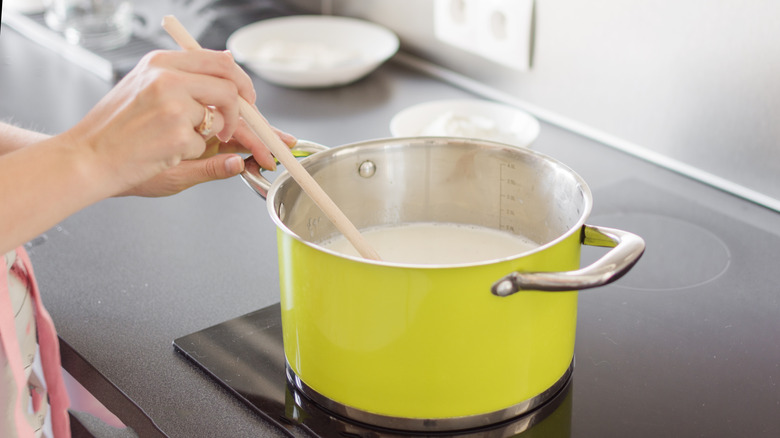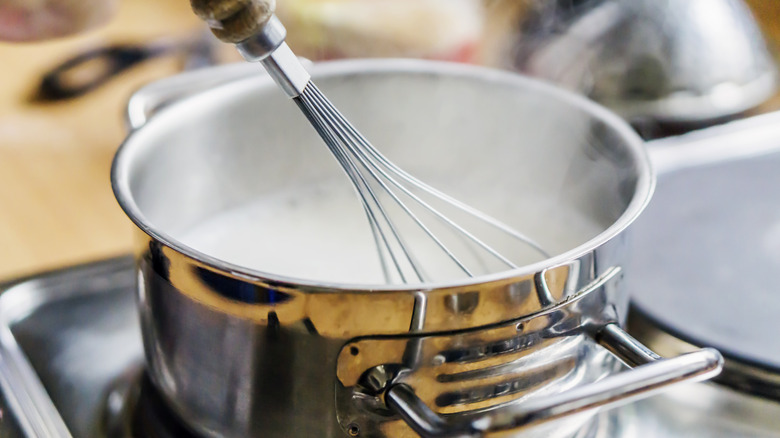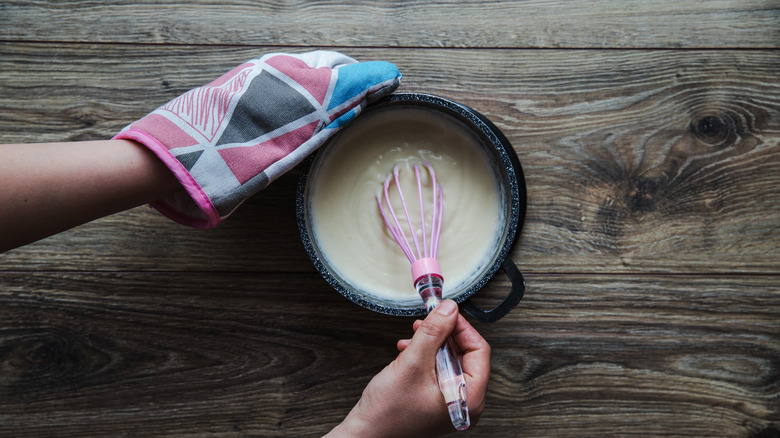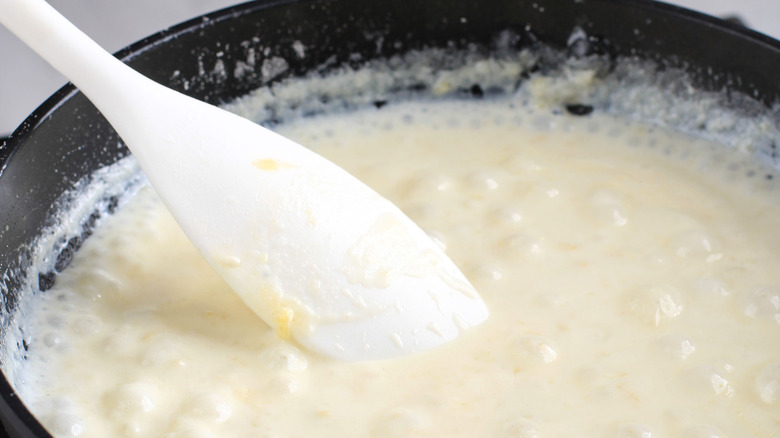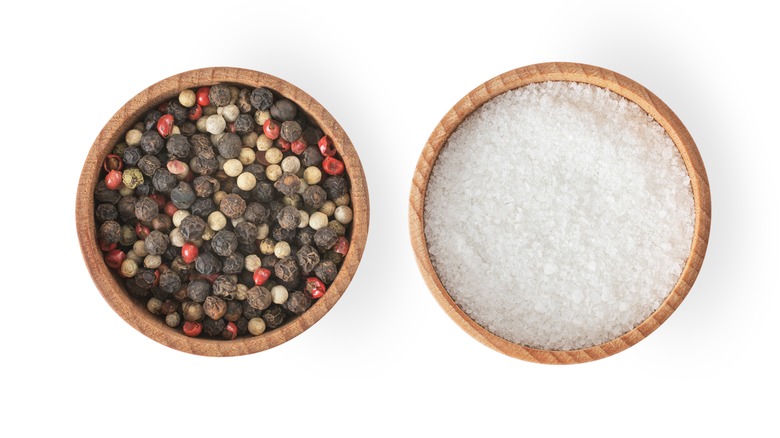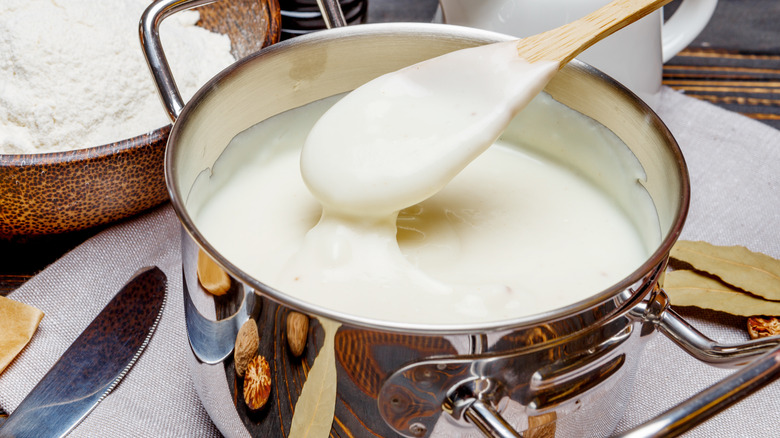12 Tips You Need When Making Béchamel Sauce
Whether it's slathered on a perfectly toasted croque monsieur, nestled between sheets of pasta and meat sauce in a lasagne bolognese, or the base for a creamy Mornay sauce, béchamel is the mother sauce you need to get to know. Mother sauces are the five sauces in French cuisine that almost all other sauces are based on. They include tomato sauce, hollandaise, espagnole, velouté, and béchamel.
Béchamel is made with a few pantry staples that you likely have on hand. All you need is butter, flour, and milk. It's an easy, straightforward recipe that requires mastery of basic culinary techniques. Learning to make a proper béchamel was one of the first techniques we learned in culinary school.
Also known as white sauce, béchamel is the base for the gravy in the sausage gravy, typically served on a bed of biscuits. The oil and juices rendered from the sausage replace the butter, but the addition of flour and milk remains the same. Velouté sauce is similar to béchamel sauce. Both call for butter and flour, but velouté sauce requires the addition of chicken, fish, or vegetable stock instead of milk. Béchamel is a versatile sauce with many delicious uses, but as simple as it is to prepare, it's just as easy to make a mess of it. Here are the tips you need to whisk up a perfect béchamel sauce every time without fail.
Choose the best ingredients
Ingredient quality is essential in all recipes, especially those requiring only a few items. Butter, flour, and milk are what béchamel is made of, and they all work together, each playing a specific role in how the sauce comes together. You'll want to choose the best versions of these staples to produce a sauce that has superior texture and taste.
You can use standard sticks of butter to make béchamel, but consider using clarified butter or ghee for a richer result. Clarified butter is standard butter that has been heated and strained to remove water and milk solids. The result is butter without any impurities and a much higher smoke point, making it harder to brown and burn. Ghee is made by continuing to cook clarified butter for longer, making it a more flavorful addition to your béchamel sauce.
All-purpose flour is the best choice for béchamel sauce. It has the right gluten and starch content balance to thicken the sauce to just the right consistency. Flours with a higher starch content, like cake flour, can over-thicken your sauce. The fat in whole milk gives béchamel its trademark creamy texture. You can substitute 2% milk for a lighter sauce, but your sauce will not have the velvety consistency of a sauce made with a higher fat content.
Gather the right tools
Choosing the right equipment for the job is one of the best and easiest ways to set yourself up for success in the kitchen, especially when making something as delicate as a béchamel sauce. While béchamel sauce doesn't require complex cooking techniques, it does take some kitchen acumen, and using the most appropriate tools can make the difference between a perfect sauce and a disappointing mess.
A heavy-bottomed pot is the first thing you should grab. Heavy-bottomed pots get their name from the weight that comes from their extra thick bottoms. The thicker bottom allows the pots to distribute heat more evenly than thinner pots and pans. Even heat distribution prevents hot spots that can cause food, especially heat-sensitive foods like the flour in béchamel sauce, from burning or cooking unevenly.
You'll also need a whisk to prepare this sauce. A whisk will allow you to easily incorporate the flour and milk, preventing any lumps from forming. A smooth, lump-free texture is one of the things béchamel sauce is known for, and using a whisk makes it easy to reach this goal. Choose a whisk that will reach the ingredients in the corners of your pot to ensure nothing gets stuck there and burns. A wooden spoon can also work to stir your béchamel, but a whisk gives you the added bonus of eliminating lumps.
Get the proportions right
There are some kitchen tasks that are less recipe and more technique, and once you master the method, you no longer need the instructions. Béchamel sauce is one of these tasks. Exact measurements and precise directions make life easier in the kitchen, but with the help of simple ratios, you can make a béchamel sauce and other items like wild rice, meat marinades, and tasty vinaigrettes without them.
A roux is the basis of béchamel sauce. It's made with equal parts fat and flour. For béchamel, the fat is typically butter, but oil can be used as well. A roux becomes béchamel when the milk is whisked into it and simmered. The amount of milk you add to the roux is also part of the ratio for making béchamel. Generally, 2 tablespoons of flour whisked into 2 tablespoons of melted butter is enough to thicken 1cup of milk.
Getting the ratios right is an essential step in making a perfect béchamel sauce. Too much roux and not enough milk will give you a thick paste instead of a creamy, pourable sauce. Alternatively, too little roux will leave your sauce thin and watery. Fortunately, béchamel sauce is both flexible and forgiving. If your sauce is too thick, simply whisk in more milk, one tablespoon at a time, until you reach your desired consistency. Continue cooking a thin béchamel to allow it to reduce and thicken further.
Melt butter before adding flour
The first step in making a béchamel sauce is to make a roux, and the first rule of roux is to melt the butter. Melting the butter accomplishes two things. First, it makes it easier for the butter to absorb the flour. When melted, the fat in the butter coats each flour particle, which stops them from lumping together when a liquid is added.
Melting the butter also transforms its flavor, giving it a more profound, slightly nutty taste. Brown butter adds a fantastic depth of flavor to many recipes, but for béchamel, skip the browning. It will alter the color of your final sauce.
It is possible to use butter and flour to thicken foods without melting the butter by making a beurre manié. Like a roux, a buerre manié is made by combining equal parts fat and flour but without heating them. The butter and flour are pressed together and then added in clumps to the liquid you want to thicken. Unlike a roux, beurre manie is only whisked into soups or sauces at the end of cooking. Roux, on the other hand, are used as building blocks for soups, stews, and sauces. It's made at the beginning of the cooking process, and additional ingredients are added to it. Cutting the butter into small pieces will help it melt faster and more evenly.
Add flour gradually
Speed may not be the first thing you think about when you head to the kitchen to cook unless you're counting the time it takes to get a meal on the table. When making béchamel sauce, speed, or the lack thereof, can make a massive difference in the outcome of your recipe. This is especially true when you're adding the flour to your melted butter.
Once the butter is fully melted, it might be tempting to dump all of the flour into the pan at once. You can make a béchamel sauce this way, but adding the flour slowly makes it easier to keep your sauce smooth and lump-free. Adding the flour slowly is most effective when you're making a large batch of béchamel with more flour, but even when you're only adding a few tablespoons of flour, sprinkling it in a little at a time is an easy way to keep your sauce smooth as silk.
For best results, lightly sprinkle the flour evenly over the melted butter as you whisk. Repeat until all of the flour has been added. This makes it easier to incorporate the flour into the butter uniformly. It also helps keep lumps at bay.
Cook the roux
Cooking the roux is an essential step in making a béchamel sauce. Once the flour has been whisked completely into the melted butter, it's imperative that you cook the roux before adding the milk. Skipping this step can ruin your béchamel sauce and potentially make you sick.
According to the Food & Drug Administration, flour is technically a raw food. The wheat used to produce the flour could potentially have been exposed to harmful bacteria as it was grown. In order to eliminate the risk of foodborne illness, flour, like other raw foods, must be cooked before it's consumed. Raw flour has a distinctly unpleasant flavor, and if you don't cook the flour after adding it to the butter, your béchamel sauce will have a pronounced raw flour taste. The goal is to cook the roux just enough to get rid of the raw flour taste without browning it.
To ensure the roux is properly cooked, continue whisking it after the flour has been added to the melted butter. Leave the pan over the heat and whisk it vigorously for one to two minutes. It's important to whisk constantly to reduce the risk of the roux burning or browning and to stop as soon as it's done. A roux will have less thickening power the longer and the darker you cook it.
Warm the milk
Warm milk is more than a soothing nighttime drink that can help you sleep. When making béchamel, the milk makes up the bulk of the sauce, and adding fresh-from-the-fridge cold milk to a hot pan filled with a hot roux can ruin it. Instead of a thick, creamy, and smooth béchamel, you can end up with a lumpy, grainy, paste-like mixture.
When ingredients are either close to or about the same temperature, it's easier for them to meld together. This is standard practice in baking, where many recipes require ingredients from butter to eggs to be allowed to come to room temperature before using them, and it's also true for making béchamel sauce. While you may not be creaming the ingredients together, adding cold milk to your roux can cause the sauce to form clumps or even break.
Gently warming the milk on low heat before whisking it into your roux makes it easier for the roux to absorb the milk, producing a smooth, creamy sauce. It can also help you avoid the intimidating sizzle and splatter that occurs when cold food is added to a hot pan. Heating the milk will give you a béchamel sauce that is lump-free and smooth.
Add the milk gradually
Flour is not the only ingredient that should be added with care to a béchamel sauce. Once your milk is heated, you should add it gradually to your cooked roux, as well. If you add the milk all at once, it will overwhelm the roux, making it much more challenging to achieve the ideal béchamel texture and consistency.
If too much milk is added at once, it could potentially shock the roux, causing it to seize up and develop lumps immediately. Adding the milk a splash at a time lightens up the roux, making it much easier to incorporate the rest of the milk so your béchamel whisks up velvety smooth.
Even if you're using cold or room temperature milk in your béchamel, adding it a little at a time makes it easier to whisk into your roux. This method is similar to tempering, the gradual process of combining two ingredients that are at different temperatures so they slowly come to the same temperature.
Whether your milk is hot or cold, your roux will thicken immediately when the first bit hits the pan. This is exactly what's supposed to happen when a liquid is introduced to a roux. Continue whisking the milk in a few tablespoons at a time, making sure it's fully absorbed before adding more.
Whisk constantly
Whisk constantly is a direction you've likely seen many times in recipe instructions. Everything from lump-free pancakes to cheesy fondue calls for ingredients to be whisked continually throughout the mixing process. This constant moving is a multipurpose tool as it can help wipe out the dreaded and unwanted lumps and also keep food from overcooking or burning.
Whisking a béchamel sauce is slightly different than whisking foods like egg whites or whipped cream. For the latter, the goal is to whip as much air as possible into the foods to create light and airy meringue or the fluffiest whipped cream to dollop on a slice of cake or pie. When you're making a sauce, you're using your whisk to tackle multiple tasks.
In this instance, whisking is not just a means of mixing but a protective cooking method, as well. You're doing triple duty, using the whisk to evenly combine ingredients, destroy any lumps, and keep the sauce from burning or becoming too thick. Instead of moving your whisk in a manner that circulates air into the food, to mix béchamel and other sauces, drag the whisk around the bottom of the pan, making sure to get into the corners to prevent any bits of flour from settling and burning. You want to move the food around the pan to keep it from sitting still and getting too hot.
Stick to a simmer
Knowing the difference between a boil and a simmer could be the key to making a perfect béchamel sauce. A boiling liquid is easy to identify due to the large, rolling bubbles that move up to the surface of your liquid. It's an excellent cooking method for blanching vegetables and, of course, boiling eggs, but it's best to avoid bringing your béchamel sauce to a boil for any length of time. For a perfect béchamel, you want your sauce to simmer. Simmering features tiny bubbles that move through your liquid. A simmer is hot enough to activate the thickening powers of your roux with much less risk of separating the sauce.
Dairy products can be somewhat fragile where temperature is concerned. When they're cooked at temperatures higher than a simmer, they can curdle. The heat can also cause your sauce to separate. Once the hot milk is whisked into your roux, béchamel sauce should be simmered over low heat for about 10 minutes to achieve the proper consistency. Boiling béchamel sauce can also cause it to burn or thicken too quickly.
Season to taste
Béchamel is something of a blank canvas in terms of flavor. It happily accepts a flavor boost from spices and other ingredients that can be stirred in once the sauce is nearly done. On its own, béchamel has a neutral, slightly nutty taste. It balances the big flavors in foods like lasagne and croque monsieurs, but it's crucial to season the sauce before using or serving it.
Salt and pepper are the obvious options for seasoning your sauce, but there are numerous other ingredients you can add to turn a simple béchamel into something delicious and memorable. Adding white pepper will give you the benefit of pepper's heat without the visible specks of pepper that black pepper produces. Freshly grated nutmeg is a common addition to béchamel but add it sparingly. Nutmeg has an intense flavor, and a little goes a long way.
Tossing an onion pique into your bechamel as it simmers allows the sauce to absorb flavor from the onion, bay leaf, and cloves. A tablespoon or two of Dijon mustard stirred in is another way to elevate a simple béchamel. Herbs like oregano, thyme, and parsley are also tasty additions to the sauce. Stir these seasonings in at the end of cooking while the sauce simmers. You can strain the herbs and spices out of the sauce before serving for a more refined béchamel.
Be careful of consistency
Consistency is essential when making a béchamel sauce. Ideally, your sauce should be the consistency of thick gravy for most uses. If you're using the béchamel to spread on a sandwich, cook it a few minutes longer to create a thicker sauce.
You can use a wooden spoon to help you determine whether your béchamel has reached the proper sauce consistency. Dip the spoon in your sauce. It should cling to the spoon in a thin, even layer. When you drag a clean finger across the spoon through the sauce, it should take several seconds for the sauce to fill in the strip you wiped away with your finger.
Keep in mind that your sauce will continue to thicken slightly even after the pot is removed from the heat due to carryover cooking, so be sure to take it off the stove just before it reaches the ideal consistency. Carryover cooking is a term used most often for meats, but it also applies to sauces. Just because you remove the sauce from the heat source doesn't mean the cooking stops immediately.
If your béchamel is too thick, gently whisk in more warm milk, a tablespoon at a time, until the desired consistency is reached. Continue simmering a thin sauce to give it more time to thicken.
